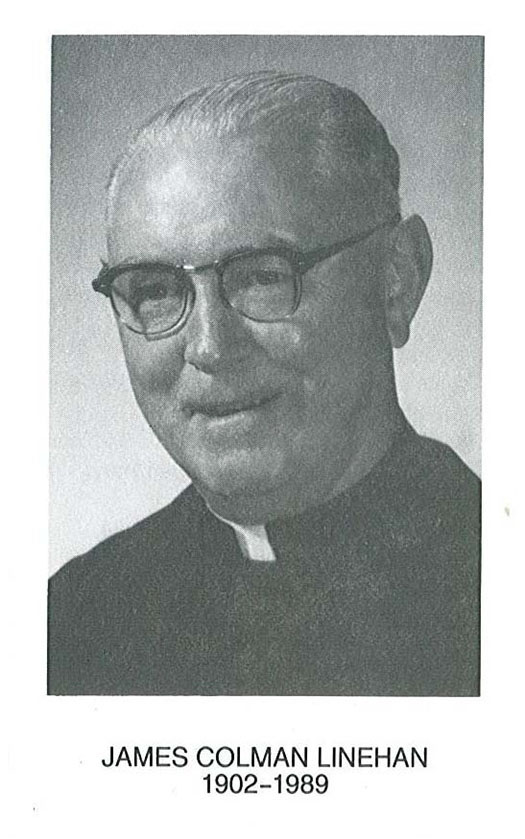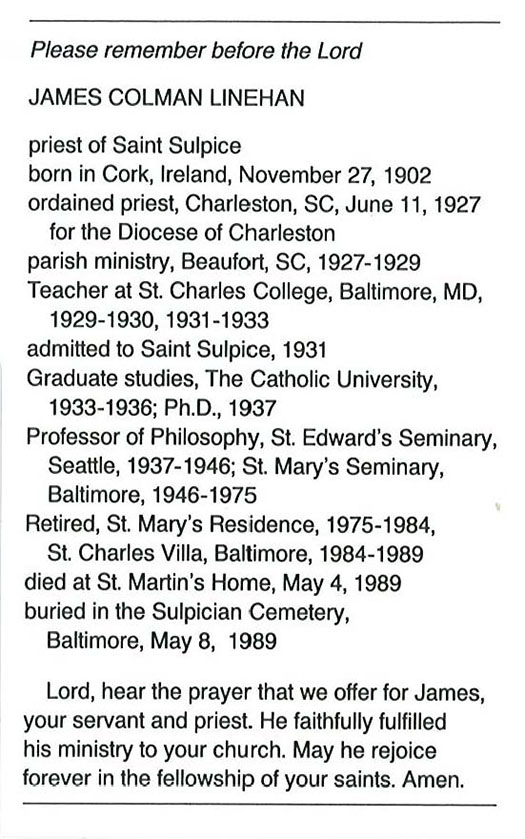Linehan, Father James Colmar
1989, May 4
Date of Birth: 1902, November 11
June 7, 1989
Dear Confrere:
The only Irish-born Sulpician serving in the United States in recent decades died peacefully on the morning of Ascension Day, May 4, 1989. The birthplace is significant since no one acquainted with James Colman Linehan could ever doubt that he was deeply rooted in Ireland, probably in County York, too, and very likely close to Blarney Castle. Indeed, as a boy he often guided tourists around the Castle and its famous stone near his family home, proudly named “Fatima.”
James Linehan was born on November 11, 1902, the son of Daniel and Ellen (nee Henshon) Linehan. His formal education began in the Monastery Schools of Cork. His college years, with a major in philosophy, were spent with the Jesuits in Limerick at Mungret College. Hearing a call to the priesthood, he affiliated with the Diocese of Charleston. Bishop William T. Russell then directed him to St. Mary’s Seminary in Baltimore for his theological studies. Gifted with a keen memory, he completed his preparation for the priesthood and was ordained on June 11, 1927, not in Charleston, for Bishop Russell had died three months before, but in New York’s St. Patrick’s Cathedral by Patrick Cardinal Hayes. The next day the new priest celebrated Mass at the Jesuits’ St. Ignatius Church. After a visit with his family in Ireland, he was assigned by newly appointed Bishop Emmet M. Walsh to assist the pastor of Beaufort, South Carolina, and its several mission churches.
Almost two years later Father Linehan wrote to the Sulpician provincial, Father John Fenlon, and applied for admission to our Society of diocesan priests and declared his readiness to begin the year of formation in the fall of 1929. He had been encouraged in this desire, he wrote, by his seminary director, Daniel Duffy, S.S., and most recently by Anthony Vieban, S.S. Bishop Walsh had given his approval also. Following a visit to Father Fenlon, he was accepted as a Sulpician candidate and assigned to St. Charles College to teach Latin and religion. Father Fenlon, meanwhile, offered an unattached seminarian from New England to Bishop Walsh. Completing his ministry in Beaufort, particularly in directing a summer camp for youth which he had founded, Father Linehan reported to Baltimore while retaining his incardination with Charleston. He never made another extended visit to his Diocese.
His innate charm, lively sense of humor, and boundless store of tales and jokes attracted friends wherever he went. Many an Irish student in local universities was befriended by him and he mingled easily with the simple and the great, especially if they had Irish connections. After teaching successfully for a year at St. Charles, he did parish work for the summer in Brooklyn, a pattern that he followed in the New York area for some fifteen years. That fall he entered the Sulpician year of formation, then located in a house on the St Charles campus. At Thanksgiving he obtained an unusual permission for the year of solitude to visit his sister in New York who was alone with her two young daughters following the break-up of her marriage. Family troubles became another pattern that would absorb Father Linehan’s attention. His restless energy and numerous social commitments, which “might not fit the quiet Sulpician life,” were noted by his superiors at the end of that year before he rejoined the faculty of St. Charles. At Christmas he was in Cork as Daniel, his father, breathed his last, a grievous loss accepted with deep faith by the family.
The following year Father Linehan was one of several young Sulpicians assigned to graduate studies, his appointment being to obtain a doctorate in philosophy at The Catholic University in Washington. His four years there from 1933 to 1937 were interspersed with summers in New York parishes, including one when he also studied German and philosophy at Columbia University. In January 1936, his sister in Brooklyn died suddenly. While a Boston cousin cared for the two children, Father Linehan disposed of the household goods, negotiated living arrangement for the young girls with relatives, and personally escorted them by ship to Ireland. His distress over these family events cost him the entire semester at the University. He successfully completed his degree requirements the following year.
The Sulpician authorities saw a natural opening in Seattle for the newly minted Doctor of Philosophy, where St. Edward’s Seminary was expanding from a minor seminary to a full twelve-year program, including philosophy and theology. The Diocese also had a large contingent of Irish priests, not all of whom had been pleased by the founding of a seminary in the Pacific Northwest. Father Linehan was seen as one who would help to win their good will, the provincial noting, “I hardly know anyone who is able to make friends as he is” and also advising the rector to keep Father Linehan busy.
Back in New York the next summer, he left his parish in early July to visit his mother in Cork, where he found her less ill than relatives had reported. While his social visits and travel in the Western United States were considerable during these years, he assured the provincial that his friends, many as they were, never interfered with his doing God’s work. That included the distinction of celebrating in 1939 the first Mass in the new mission in Bothell, which grew into the large suburban parish in which St. Edward’s Seminary was situated. In 1940, his summer parish ministry was preceded by the great joy of receiving his niece into religious life in Baltimore, the elder of the two girls he had taken to Ireland after their mother’s death. Her departure from the convent fourteen years later was an equally great sorrow for him.
Trips to Ireland during the war years were impossible, and his mother died there in the summer of 1942. In late 1945, Father Linehan presented a paper and led a discussion on “Democracy and World Order” at the meeting in Milwaukee of the American Catholic Philosophical Association.
With American troops on their way home from victory in Europe and Japan, Father Linehan was soon on his way to Ireland in the summer of 1946, having learned a few days before he sailed of his appointment to St. Mary’s Seminary on Paca Street as professor of philosophy, along with the title of vice-rector. It was late October before he could secure plane transportation back to the United States to take up his new duties. Except for a sabbatical year in 1968-1969, Father Linehan continued to teach philosophy courses at St. Mary’s until his retirement in 1975, even after the school of philosophy merged with the junior college at St. Charles while he continued to live downtown on Paca Street.
Those years witnessed longer and more frequent visits home, sometimes two or three times a year. As the last survivor of his generation of the family, he inherited “Fatima,” and thus always had a home to call his own. One of his brothers died in 1950, another in 1966, and his last two sisters in the 1970s.
After the war years, his summer parish work shifted from New York to Daytona Beach and Fort Lauderdale, except one summer in Seattle, where the pastors were Irish friends. Early in his teaching career, Father Linehan’s superiors had expressed their concern that his many outside interests might have a negative impact on his seminary ministry. Though he never acknowledged it, that regrettably proved to be the fact. His teaching and class preparation did suffer in later years, he lost contact with the needs and interests of his students, and administrative responsibilities were neglected. His deep desire for independence, coupled with the weakening of his faculties in his last years, made life more difficult for him and for those who loved and cared for him. Only after repeated injuries from falls was he finally persuaded in 1985 that he had to move to St. Charles Villa, where he often grieved at the loss of easy access to friends and convenient transportation.
Yet at times his radiantly warm and charming manner sparkled with the wit and poetry which had entertained his countless friends for more than 80 years. In his last months Father Linehan also was the beneficiary of the devoted care of the Little Sisters of the Poor and their staff in the infirmary of St. Martin’s home. It was there that he died, going home with his Lord on Ascension Thursday for the last time, as his homilist remarked.
The principal celebrant of a Mass of Christian burial on May 9 was the Very Reverend Gerald L. Brown, provincial of St. Sulpice. The homily was delivered by the Reverend John W. Bowen, S.S. Burial was in the Sulpician cemetery. A grandniece and several cousins survive.
May Father Linehan live forever in the joy of the Resurrection.
Sincerely yours in Christ,
William J. Lee, S.S.
Provincial Secretary


